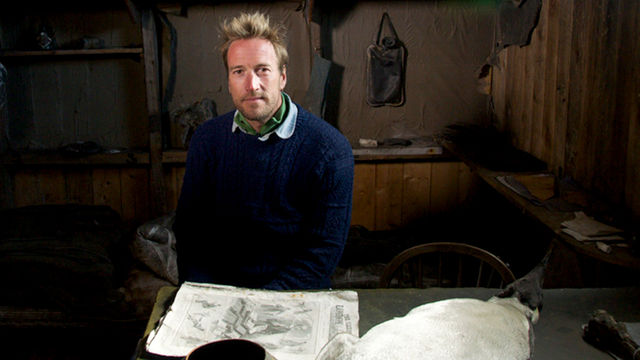 It's
worth taking a moment - while decrepit 'granpa' Dodge hollers sour
nothings at his wife Halie - to study the extraordinary design of
this Curve
Studio production.
Sam Shepard's
darkly comic and disturbing Pullitzer-winning play Buried Child is
set in an Illinois rural backwater in 1978. The stage bristles with
towering stalks of corn growing out of a giant wooden rack that lifts
to become the roof of a prairie homestead. It makes the ramshackle
house appear like an underground bunker into which this dysfunctional
family have retreated. Earthy roots might thrust through its ceiling
any day now. Grimy windows are lit by sloshing rain. Mesh screens
partition walls, doors and verandah so that characters seem to move
between grey veils. A fine mist drifts across the living room, caught
in light shafts which colour with changing hours but also pulse with
the emotional undercurrent of this psycho-drama. The whole structure
seems creepily alive.
It's
worth taking a moment - while decrepit 'granpa' Dodge hollers sour
nothings at his wife Halie - to study the extraordinary design of
this Curve
Studio production.
Sam Shepard's
darkly comic and disturbing Pullitzer-winning play Buried Child is
set in an Illinois rural backwater in 1978. The stage bristles with
towering stalks of corn growing out of a giant wooden rack that lifts
to become the roof of a prairie homestead. It makes the ramshackle
house appear like an underground bunker into which this dysfunctional
family have retreated. Earthy roots might thrust through its ceiling
any day now. Grimy windows are lit by sloshing rain. Mesh screens
partition walls, doors and verandah so that characters seem to move
between grey veils. A fine mist drifts across the living room, caught
in light shafts which colour with changing hours but also pulse with
the emotional undercurrent of this psycho-drama. The whole structure
seems creepily alive. |
| Matthew Kelly & Matthew Rixon |
Eventually,
Matthew Kelly
reels in your attention towards his shambolic patriarch stranded on a
filthy sofa that hides more than whisky bottles. Good as he is, the
most mesmerising performances from an impressive ensemble cast were
the two brothers, Tilden (played by Kelly’s own son, Matthew
Rixon)
and Bradley (Michael
Beckley).
As broken as the furniture, these two lumber through interlocking
rooms, trapped in the wooden interior. Rixon's portrait is more
subtle. A scene where he spreads shelled corn husks over his sleeping
father is both clumsily reverent and sinister, funereal even. This is
matched by Beckley creeping up on his prone father with an electric
shaver. Beckley plays this son as a horror movie grotesque but his
twitching angularity and twanging voice are never less than
startling. Even grovelling on the sofa, whining for his prosthetic
leg, he is menacing. A looming nightmarish figure amidst the grimy
realism, you look to him for the violence this play persistently
threatens.
With
Act Two, the pace picks up as two youngsters arrive; Vince and his
girlfriend Shelly. Vince (Lloyd
Thomas)
is disturbed to find that his father and grandfather fail to
recognize him after a six year absence. Except we don't know if they
are his family. Shelly, (Catrin
Stewart),
a brash but winning young city woman, articulates our unease and asks
the questions. She eventually concludes it is the house's
inhabitants, not her, who are the 'strangers'. Shelly unpicks
allusions to a family scandal but the play's title means it's never
hard to guess where this is going. What it lacks in mystery though,
it makes up in a sullen festering tension.
 |
| Lloyd Thomas & Catrin Stewart |
Finally, matriarch Halie returns with a bumbling Father Dewis (Gary Lilburn) who might or might not be her beau with his garish bouquet of yellow roses. Jane Lowe, in vintage fifties frocks, blends the faded glamour of a Blanche Dubois with the cracked facade of a Baby Jane. 'I don't know what my role is here,' mutters the priest in a recurring Absurdist complaint about muddled identities. Through the miasma of secrets and confusion, it is the staging which delivers a climactic moment. The cornstalks pierce the rotten heart of the family in an uncanny mutation and Shepherd's armoury of symbols is once more re-arranged.
It seemed only afterwards fitting to tumble into a city under siege
from swirling November fog. 'Buried Child' runs till
December 3rd at the Curve and deserves full houses throughout for
this impressive revival of an American Gothic classic.
















 When Shackleton was recruiting for his
When Shackleton was recruiting for his 